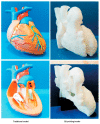Dimensional Accuracy and Clinical Value of 3D Printed Models in Congenital Heart Disease: A Systematic Review and Meta-Analysis
- PMID: 31540421
- PMCID: PMC6780783
- DOI: 10.3390/jcm8091483
Dimensional Accuracy and Clinical Value of 3D Printed Models in Congenital Heart Disease: A Systematic Review and Meta-Analysis
Abstract
The aim of this paper is to summarize and evaluate results from existing studies on accuracy and clinical value of three-dimensional printed heart models (3DPHM) for determining whether 3D printing can significantly improve on how the congenital heart disease (CHD) is managed in current clinical practice. Proquest, Google Scholar, Scopus, PubMed, and Medline were searched for relevant studies until April 2019. Two independent reviewers performed manual data extraction and assessed the risk of bias of the studies using the tools published on National Institutes of Health (NIH) website. The following data were extracted from the studies: author, year of publication, study design, imaging modality, segmentation software, utility of 3DPHM, CHD types, and dimensional accuracy. R software was used for the meta-analysis. Twenty-four articles met the inclusion criteria and were included in the systematic review. However, only 7 studies met the statistical requirements and were eligible for meta-analysis. Cochran's Q test demonstrated significant variation among the studies for both of the meta-analyses of accuracy of 3DPHM and the utility of 3DPHM in medical education. Analysis of all included studies reported the mean deviation between the 3DPHM and the medical images is not significant, implying that 3DPHM are highly accurate. As for the utility of the 3DPHM, it is reported in all relevant studies that the 3DPHM improve the learning experience and satisfaction among the users, and play a critical role in facilitating surgical planning of complex CHD cases. 3DPHM have the potential to enhance communication in medical practice, however their clinical value remains debatable. More studies are required to yield a more meaningful meta-analysis.
Keywords: 3D model; 3D printing; additive manufacturing; congenital heart defect; congenital heart disease; stereolithography.
Conflict of interest statement
Authors declare no conflicts of interest.
Figures





References
-
- Biglino G., Koniordou D., Gasparini M., Capelli C., Leaver L.-K., Khambadkone S., Schievano S., Taylor A., Wray J. Piloting the Use of Patient-Specific Cardiac Models as a Novel Tool to Facilitate Communication During Clinical Consultations. Pediatr. Cardiol. 2017;38:813–818. doi: 10.1007/s00246-017-1586-9. - DOI - PMC - PubMed
-
- Ma X.J., Tao L., Chen X., Li W., Peng Z.Y., Chen Y., Jin J., Zhang X.L., Xiong Q.F., Zhong Z.L., et al. Clinical application of three-dimensional reconstruction and rapid prototyping technology of multislice spiral computed tomography angiography for the repair of ventricular septal defect of tetralogy of Fallot. Genet. Mol. Res. 2015;14:1301–1309. doi: 10.4238/2015.February.13.9. - DOI - PubMed
Publication types
LinkOut - more resources
Full Text Sources
Research Materials
Miscellaneous

